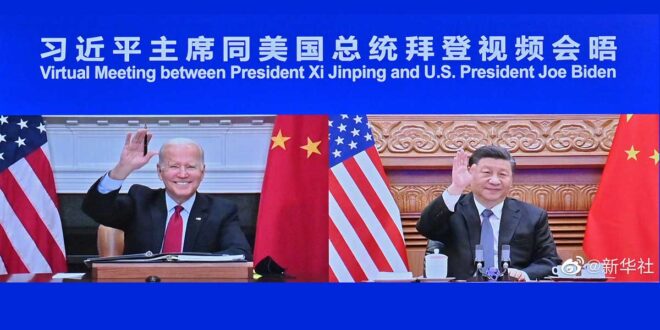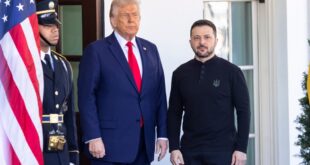Giancarlo Valori
The so-called US vision of a free and open Indo-Pacific region is essentially a strategy to divide the countries in the area, and incite in-out confrontation. It goes against the trend of times in the Asia-Pacific region, namely peaceful development and win-win cooperation.
The Biden Administration’s Indo-Pacific strategy is contradictory: the USA claims to promote freedom and openness in the region as a goal, while in reality co-opting with allies to forge the 5-4-3-2-1 countdown system.
The Five Eyes (FVEY): the intelligence and surveillance alliance comprising Australia, Canada, New Zealand, the United Kingdom and the United States of America.
The Quad Mechanism (Quadrilateral Security Dialogue): the informal strategic alliance between Australia, Japan, India and the United States of America with the aim of containing China in the Indo-Pacific region.
AUKUS, a trilateral security pact between Australia, the United Kingdom and the United States of America, announced on September 15, 2021.
Bilateral alliances.
The Indo-Pacific Economic Framework (IPEF): a plan for investment and strengthening trade relations that aims to increase the US presence in the region and counter Chinese influence. For some observers, however, IPEF actually serves to dampen allies’ criticism of the nature of US strategy in the region, focused only on military presence and lacking concrete economic implications, unlike the Chinese policy in the macro-region.
AUKUS supports Australia in building nuclear-powered submarines and developing hypersonic weapons, increasing the risk of a regional arms race and world war.
Under the pretext of combating illegal fishing and making supply chains resilient, Quad has vigorously pursued military cooperation and intelligence sharing. The USA has also encouraged NATO’s involvement in the Asia-Pacific region. These are all attempts to make an Asia-Pacific version of NATO materialise and promote integrated deterrence against the People’s Republic of China.
The Indo-Pacific strategy is causing growing alarm and concern in many countries in the Asia-Pacific region. As reported by the BBC, in April 2021, New Zealand’s Foreign Minister Nanaia Mahuta, expressed her country’s discomfort with the expansion of the Five Eyes’ mandate, thus putting pressure on the People’s Republic of China, while New Zealand prefers to pursue peaceful bilateral relations with the People’s Republic of China.
The Indo-Pacific strategy is causing growing alarm and concern in many Asia-Pacific countries. As reported by the BBC, in April 2021, New Zealand’s Foreign Minister, Nanaia Mahuta expressed New Zealand’s discomfort with the expansion of the Five Eyes mandate, thus putting pressures on China, while New Zealand prefers to pursue peaceful bilateral relations with the People’s Republic of China.
Last May, at the special US-ASEAN Summit, the countries of the Association of South-East Asian Nations (ASEAN) – namely Brunei, Cambodia, Indonesia, Laos, Malaysia, Myanmar (Burma), Philippines, Singapore, Thailand, Vietnam (Papua New Guinea and East Timor as observers) – emphasised their aspiration for peace and cooperation, not for posturing, division or confrontation.
The United States of America has made it clear that IPEF will enable it to win the race of the 21st century. This means that IPEF is designed to serve only the US economy. Long ago the White House shelved the idea of developing the Free Trade Area of the Asia-Pacific. The USA walked out of the Trans-Pacific Partnership, and refused to join the Comprehensive and Progressive Trans-Pacific Partnership. This exposes the US one-sided nature and its selective approach to international institutions. It is about US self-interest, and nothing mutually beneficial.
IPEF is a US political instrument to sustain its hegemony in the regional economy. The essence is to dominate supply and value chains, as well as the new economic sectors, and marginalise specific countries. The United States has chosen to make economic issues sound as political and ideological ones, using the economy to force regional countries to side in-out with China or the USA.
US Trade Representative Katherine Tai has publicly stated that IPEF is a stand-alone agreement independent of China. US Secretary of Commerce Gina Raimondo said that IPEF marked the restoration of US economic leadership in the region and provided Indo-Pacific countries with an alternative to the Chinese approach. Earlier, she had also stated that IPEF could harmonise export controls and other “poison pills”, such as restricting the export of sensitive products to China.
IPEF seeks to establish US-led trade rules, as well as restructure the industrial chain system and economically and scientifically “decouple” the neighbouring countries from China. Many countries in the region are worried and believe that the cost of such “decoupling” will be huge. Former Malaysian Prime Minister Mahathir Mohamad noted that any trade alliance excluding the world’s second largest economy could not be conducive to closer multilateral trade cooperation in the Indo-Pacific region. The exclusion of China by the United States is not an economic but a political issue.
Hailed as “menu approach” cooperation, IPEF actually takes little account of the level of development and the real needs of the countries in the region. It barely makes concessions to developing countries on tariff reductions and market access, but forces participants to accept the so-called high standards of the United States of America and its unilateral agenda. IPEF focuses exclusively on the US direct interests and cares little for the other parties’ needs. There is no mutual benefit in IPEF.
In its report Regional Perspectives on the Indo-Pacific Economic Framework, the US Center for Strategic and International Studies has emphasised that IPEF has little more to offer than expanding the US economic presence in the region. It does not tackle the issues of the larger interests of the countries in the region. There is widespread concern that IPEF will only benefit the United States of America, while heavily burdening the participating regional countries.
The People’s Republic of China is committed to the path of peaceful development and of the five principles of peaceful coexistence, while opposing the practice of the bigger and stronger party prevailing over the smaller and weaker ones. By depicting China as a threat and using “freedom of navigation” as a pretext to undermine Chinese sovereignty, security and maritime rights and interests, the United States poses serious concerns to regional peace and security. In a way the interference in Ukraine, which has led to the war between the parties, is already a stern warning.
In Asia and around the world China upholds equality among all countries regardless of their size. It respects each State’s choice of the development path suited to its national conditions, and does not seek any sphere of influence. China pursues a defence policy of a defensive nature and an active defence military strategy. In developing its defence capabilities, China aims to safeguard its sovereignty, security and development interests and does not target any other country. The growth of China’s defence capabilities enhances the force for world peace, so that no country dictates its conditions to the international community. It is therefore utterly ridiculous and provocative – as unfortunately happens to read in some embedded press – to claim that China has the ambition to create a sphere of influence in the Pacific region, especially in the area of the South China Sea and East China Sea. The same holds true for the claim that some usual Western countries will continue to oppose China’s “illegal” activities in these two seas, and that these countries will support other States in the region in defending their maritime rights (i.e. Western foreign war fleets’ ones), and seek allies and friends to defend freedom of navigation and overflight of foreign fleets and air forces that they would like to continue to fly and sail at will, even against international law. Let us take a closer look.
The People’s Republic of China is the first country to have discovered, named, explored and exploited the Nanhai Islands and its waters, as well as the first one to have exercised sovereignty and jurisdiction over them continuously, peacefully and effectively. The Chinese sovereignty over the Nanhai Islands and its rights and interests in the South China Sea have been established throughout the long course of history. They are firmly rooted in history and law and have been upheld by successive Chinese governments and recognised by the international community. In accordance with the Cairo Declaration of 1943 and the Potsdam Declaration of 1945, China reclaimed territories illegally occupied by Japan, including the Paracel Islands (Xisha Qundao) and the Spratly Islands (Nansha Qundao) after World War II, and has since asserted sovereignty and strengthened jurisdiction by establishing official names, publishing maps, creating administrative units, deploying and stationing troops.
The resumption of China’s exercise of sovereignty over the Nanhai Islands is a legitimate and lawful act to inherit China’s rights established throughout history. It is also part of the post-World War II international order and has been recognised by countries around the world, including the United States of America.
Moreover, thanks to the joint efforts of China and the ASEAN countries, the overall situation in the South China Sea remains stable. With the full and effective implementation of the Declaration on the Conduct of Parties in the South China Sea (DOC), signed by China and ASEAN members at the 8th Phnom Penh Summit on November 4, 2002, freedom of navigation and overflight, peaceful settlement of disputes and self-control in the conduct of activities are reaffirmed.
In this regard, the parties have stepped up dialogue, appropriately managed divergences, deepened cooperation and enhanced mutual trust, as well as made active progress in advancing the consultations on the Code of Conduct (COC) in the South China Sea, in an effort to jointly safeguard peace and stability in that sea and positively shape regional and global security, stability and prosperity. Despite COVID-19, the parties held video-conference meetings of senior officials on the implementation of DOC and ten joint working group meetings via video link to advance consultations on the COC text. On June 22, 2022 the first face-to-face consultations on the COC since COVID-19 were held in Cambodia. This positive progress says a lot about the determination and commitment of the countries in the region to pursue the COC consultations steadfastly.
China respects and supports the freedom of navigation and overflight of all countries in the South China Sea, in accordance with international law, and actively protects security and free passage through international sea routes. The South China Sea is indeed one of the safest and freest shipping lanes in the world. Fifty per cent of the world’s merchant ships and a third of international maritime trade, as well as over 100,000 merchant ships, pass through it every year. Freedom of navigation and overflight in the South China Sea has never been an issue.
The Diaoyu (Senkaku) Islands and the surrounding ones are China’s territory. Chinese patrol and law enforcement missions in the waters off the Diaoyu Islands are legitimate measures taken by China to exercise its sovereignty, in accordance with law, and are necessary responses to Japanese provocations in violation of Chinese sovereignty. No country should misjudge the strong determination of the Chinese government to safeguard sovereignty and territorial integrity. At the same time, the People’s Republic of China remains committed to managing and resolving problems properly through dialogue and consultation and has made great efforts to maintain maritime stability. In 2014 a four-point consensus in principle was reached between China and Japan to manage and improve bilateral relations. It includes a clear understanding for managing the situation regarding the Diaoyu Islands and the East China Sea.
While acting according to the logic of the Monroe Doctrine, the United States of America often uses power politics, as well as hegemonic and imposing actions, to flagrantly undermine the international maritime order so as to sustain its maritime dominance. In the 246-year history of the United States, there were only 16 years in which the country was not at war with others. The United States of America operates over 800 military bases in 80 countries and regions. Its military spending, which has grown consecutively for years, accounts for a quarter of the world total and is equivalent to the military spending of the world’s top nine countries combined. The United States has recently proposed a national defence budget request of around 813 billion dollars for the fiscal year 2023. Such massive military spending makes the United States the first and only challenger. Of whom?
The United States of America ignores the history and facts regarding the South China Sea issue, deliberately fuels disputes over territorial sovereignty and maritime rights and interests, and sows discord among regional countries. It undermines stability and fuels militarisation in the South China Sea. Data from relevant organisations show that the number of US close reconnaissance activities targeting China has more than doubled in the past decade or more. An average of five US military ships currently navigate near the Chinese coast every day. In 2022, US military ships have navigated through the Taiwan Strait about once a month and large US reconnaissance aircrafts have flown over 800 times near China and have repeatedly violated China’s airspace. Under the assumption of creating trouble in the South China Sea, the United States has also encouraged its allies and collaborators to make their military ships sail the South China Sea.
On the afternoon of October 2, 2021, the Seawolf-class fast attack submarine USS Connecticut (SSN-22) struck an object while submerged and operating in international waters in the Indo-Pacific region. Only a week later, the United States released a vague statement, claiming that the submarine had hit an unknown object. A month later, it was reported that the submarine “had run aground on an unexplored seamount”. A final report on the accident was finally released by the US Navy on May 23, 2022, but no clear explanation was provided in response to the serious concerns and questions raised by many people, including: 1. the aim of the submarine; 2, the specific location of the accident; 3. whether the submarine had entered the exclusive economic zones (EEZs); or 4. even the territorial sea of other countries; and 5. whether the accident had caused a nuclear leak or damaged the marine environment.
The United States started its Freedom of Navigation (FON) programme in 1979 before signing the United Nations Convention on the Law of the Sea in Montego Bay on December 10, 1982. In defiance of the new maritime order, it signed but did not ratify the Convention. The signature entails no obligation for the State, but merely serves to authenticate the text: it is only with ratification that the treaty takes legal effect for the country.
The “shrewd”’ move sought to maximise US military’s freedom to expand without rules into the oceans. The FON Programme is not consistent with universally recognised international law, disregards the sovereignty, security and maritime rights and interests of many coastal countries, and seriously jeopardises regional peace and stability. Its goal is to promote US maritime supremacy under the pretext of “freedom of navigation”. The FON Programme has been strongly opposed by many members of the international community, particularly the developing countries, and is in itself a threat to world peace.
 Geostrategic Media Political Commentary, Analysis, Security, Defense
Geostrategic Media Political Commentary, Analysis, Security, Defense





